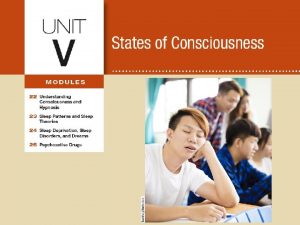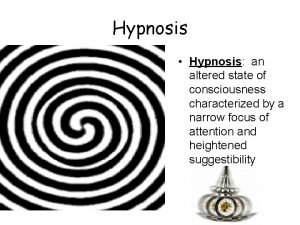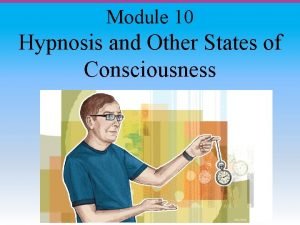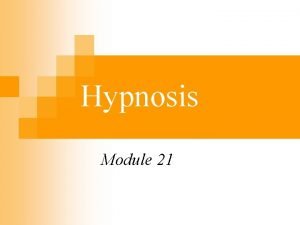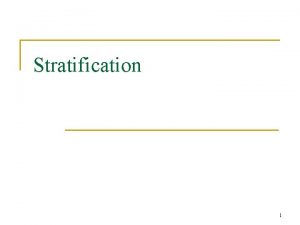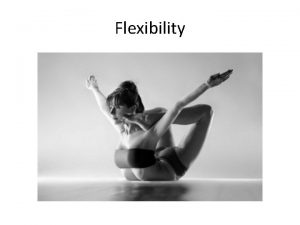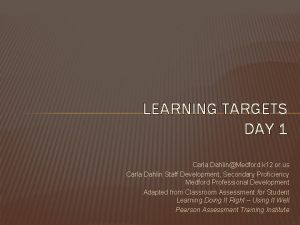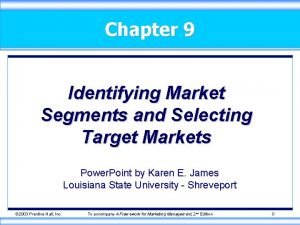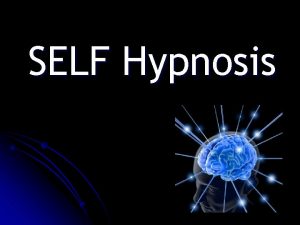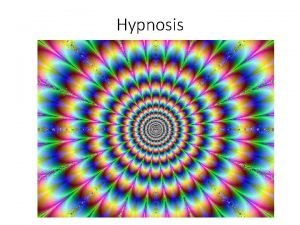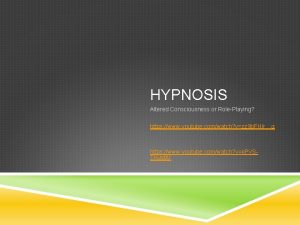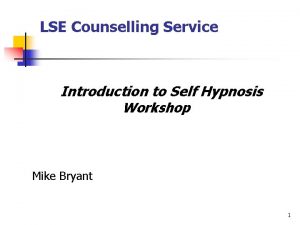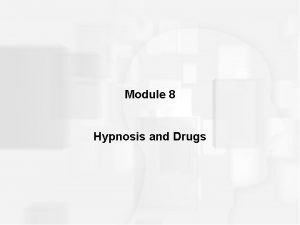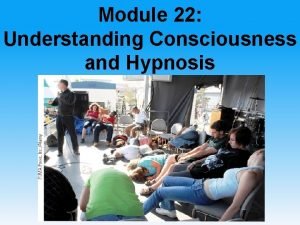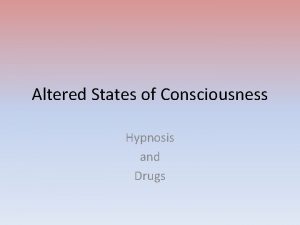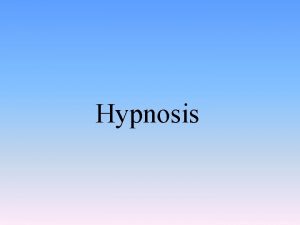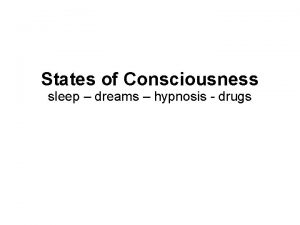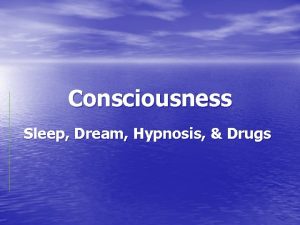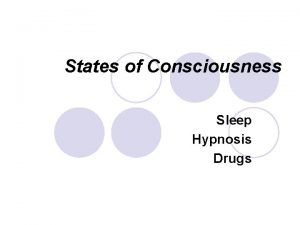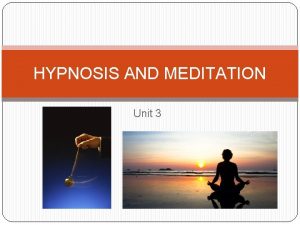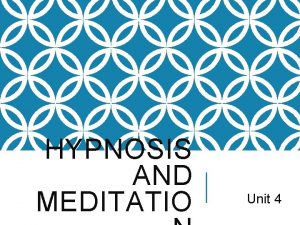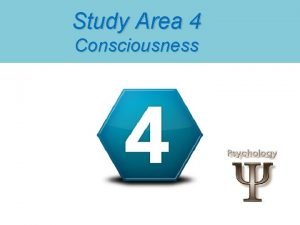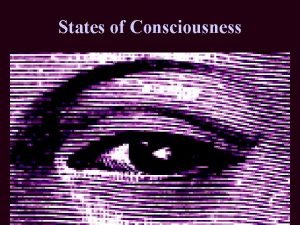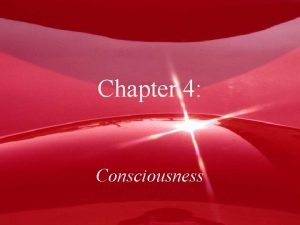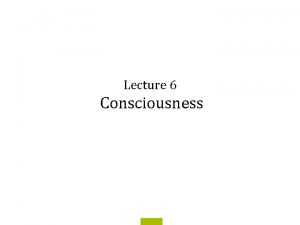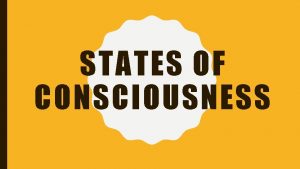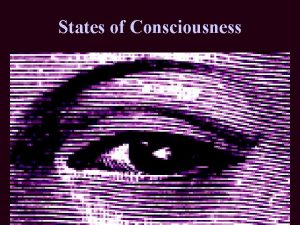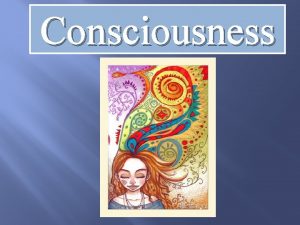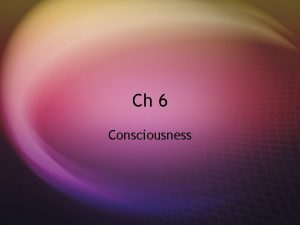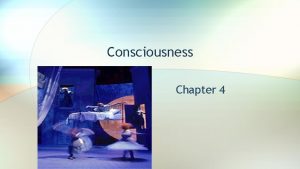Learning Targets Module 22 Understanding Consciousness and Hypnosis


























- Slides: 26


Learning Targets Module 22 Understanding Consciousness and Hypnosis 22 -1 Describe the place of consciousness in psychology’s history. 22 -2 Define hypnosis, and describe how a hypnotist can influence a hypnotized subject. 22 -3 Discuss whether hypnosis is an extension of normal consciousness or an altered state.

Who were two major figures in consciousness research? William James discussed a continuous “stream of consciousness, ” with each moment flowing into the next. Sigmund Freud believed the unconscious was a hiding place for our most anxietyprovoking ideas and emotions, and that uncovering those hidden thoughts could lead to healing.

What is the place of consciousness in psychology’s history? In the early half of the twentieth century, the study of consciousness was abandoned for behaviorism. Psychologists wanted to talk about what could be seen. After 1960, the study of mental process rebounded. Neuroscience linked brain activity to consciousness. The study of cognition and how it is altered is now a large field of study.

What is consciousness and what are some aspects of it? Consciousness is our subjective awareness of ourselves and our environment. Our conscious awareness is one part of the dual processing of our two-track minds. Although much of our information processing is conscious, more is unconscious and automatic — outside our awareness.

What is hypnosis? Hypnosis is a social interaction in which one person (the hypnotist) suggests to another (the subject) that certain perceptions, feelings, thoughts, or behaviors will spontaneously occur.

Altered states of consciousness In addition to normal, waking awareness, consciousness comes to us in altered states, including daydreaming, sleeping, drug-induced hallucinating, and meditating.

What are some frequently asked questions about hypnosis? Can anyone experience hypnosis? Can you recall forgotten events? § To some extent, we are all suggestible. § Highly hypnotizable people, about 20% of us, are usually very imaginative. § Children also make good subjects for hypnosis. § Not really. § All of our life experiences are not actually stored in memory “banks”. § Some memories retrieved through hypnosis seem to combine fact with fiction.

What is a post-hypnotic suggestion and how effective is it? a suggestion, made during a hypnosis session, to be carried out after the subject is no longer hypnotized; used by some clinicians to help control undesired symptoms and behaviors Posthypnotic suggestions have helped alleviate headaches, asthma, and stress-related anxiety and skin disorders.

Can I be forced to act against my will? Hypnotized people who were induced to put their hand into “acid” at the command of the hypnotist they later denied that they would ever follow that order. The same researchers also tested a control group who pretended they were hypnotized. Laboratory assistants were unaware of who was hypnotized and who was not. Both groups performed the same dangerous act of putting their hand in what they believed was “acid” showing that it was not hypnosis that made them follow the command. (Orne & Evans, 1965)

What is hypnotherapy? Hypnotherapists try to help patients harness their own healing powers.

What results has hypnosis brought about? In one analysis of 18 studies, the average client whose therapy was supplemented with hypnosis showed greater improvement than 70 percent of otherapy patients. (Kirsch et al. , 1995, 1996) Hypnosis seemed especially helpful for the treatment of obesity. Drug, alcohol, and smoking addictions have not responded well to hypnosis. (Nash, 2001)

1. What Would You Answer? Myla goes to a hypnotist because she is interested in losing weight. Under hypnosis she is told that, later on, when she is hungry, she will eat less than she normally would. The hypnotist is making use of A. B. C. D. E. selective attention. dissociation. social influence. a hallucination. a posthypnotic suggestion.

What are some other frequently asked questions about hypnosis? Can hypnosis relieve pain? Yes. When unhypnotized people put their arm in an ice bath, they felt intense pain within 25 seconds. When hypnotized people did the same after being given suggestions to feel no pain, they indeed reported feeling little pain. (Elkins et al. , 2012; Jensen, 2008).

Is hypnosis an extension of normal consciousness? The social influence theory of hypnosis explains that people begin to feel and behave in ways appropriate for “good hypnotic subjects. ” The more the individual being hypnotized likes and trusts the hypnotist, the more they allow that person to direct their attention and fantasies.

Is hypnosis an altered state? Psychologist Ernest Hilgard believed hypnosis involves not only social influence but also a special dual-processing state of dissociation — a split between different levels of consciousness. Hilgard viewed hypnotic dissociation as a vivid form of everyday mind splits — similar to doodling while listening to a lecture or typing the end of a sentence while starting a conversation.

Have you ever dissociated? Have you been driving on a long highway and arrive at your exit and not quite remember passing the miles in between? Have you ever read to the end of a page and realized you hadn’t been attending to any of the words? Did you find yourself tuning out during today’s class only to be brought back to attention when the bell rang?

How did Ernest Hilgard test hypnosis? A hypnotized woman exhibited no pain when her arm was placed in an ice bath. When the same hypnotized woman was asked to press a key if some part of her felt the pain, she did

How do the two theories explain hypnosis? Dissociated mind or well-behaved subject?

2. What Would You Answer? Which of the following is the term most closely associated with the split in consciousness that allows some thoughts and behaviors to occur simultaneously with others? A. consciousness B. hypnosis C. hallucination D. dissociation E. meditation

The biopsychosocial approach explains hypnosis.

AP® Exam Tip Psychological research corrects the mistaken popular belief that hypnosis or other methods can be used to tap into a pure and complete memory bank. You will learn much more about how memory really works when you get to Unit VII. The topic of hypnosis has been seen on the AP® exam, so become knowledgeable about it.

Learning Target 22 -1 Review Describe the place of consciousness in psychology’s history. § After initially claiming consciousness as its area of study in the nineteenth century, psychologists had abandoned it in the first half of the twentieth century, turning instead to behaviorism because they believed consciousness was too difficult to study scientifically. § Since 1960, under the influence of cognitive psychology and neuroscience, consciousness (our awareness of ourselves and our environment) has resumed its place as an important area of research.

Learning Target 22 -2 Review Define hypnosis. Hypnosis is a social interaction in which one person (the hypnotist) suggests to another (the subject) that certain perceptions, feelings, thoughts, or behaviors will spontaneously occur.

Learning Target 22 -2 Review cont. Describe how a hypnotist can influence a hypnotized subject. § Hypnosis does not enhance recall of forgotten events (it may even evoke false memories). § It cannot force people to act against their will, though hypnotized people, like unhypnotized people, may perform unlikely acts. § Posthypnotic suggestions have helped people harness their own healing powers but have not been very effective in treating addiction. Hypnosis can help relieve pain.

Learning Target 22 -3 Review Discuss whether hypnosis is an extension of normal consciousness or an altered state. § Social influence theory suggests that hypnotized people act out the role of “good subject”. § Other psychologists view hypnosis as a dissociation — a split between normal sensations and conscious awareness.
 Social influence theory of hypnosis
Social influence theory of hypnosis Learning targets helping students aim for understanding
Learning targets helping students aim for understanding Is hypnosis an altered state of consciousness
Is hypnosis an altered state of consciousness Divided consciousness theory of hypnosis
Divided consciousness theory of hypnosis Module 21
Module 21 Class consciousness vs false consciousness
Class consciousness vs false consciousness Writing learning targets
Writing learning targets Agonist antagonist muscles
Agonist antagonist muscles Rough sketch and final sketch
Rough sketch and final sketch Knowledge targets examples
Knowledge targets examples Learning targets knowledge, reasoning, skill product
Learning targets knowledge, reasoning, skill product Describe velocitation and highway hypnosis
Describe velocitation and highway hypnosis Warehouse goals
Warehouse goals Identifying market segments and targets chapter 9
Identifying market segments and targets chapter 9 Identifying market segments and targets
Identifying market segments and targets Identifying market segments and targets chapter 9
Identifying market segments and targets chapter 9 Five patterns of target market selection
Five patterns of target market selection Segment invasion plan
Segment invasion plan Pituitary hormones and their targets
Pituitary hormones and their targets Smarterbalanced.alohahsap.org
Smarterbalanced.alohahsap.org Prizm segmentation scheme
Prizm segmentation scheme Arti hypnosis
Arti hypnosis The term “hypnosis” is based on the greek word for:
The term “hypnosis” is based on the greek word for: Hypnosis role play
Hypnosis role play Gym hypnosis
Gym hypnosis Nnn hypno
Nnn hypno Nnn hypno
Nnn hypno
